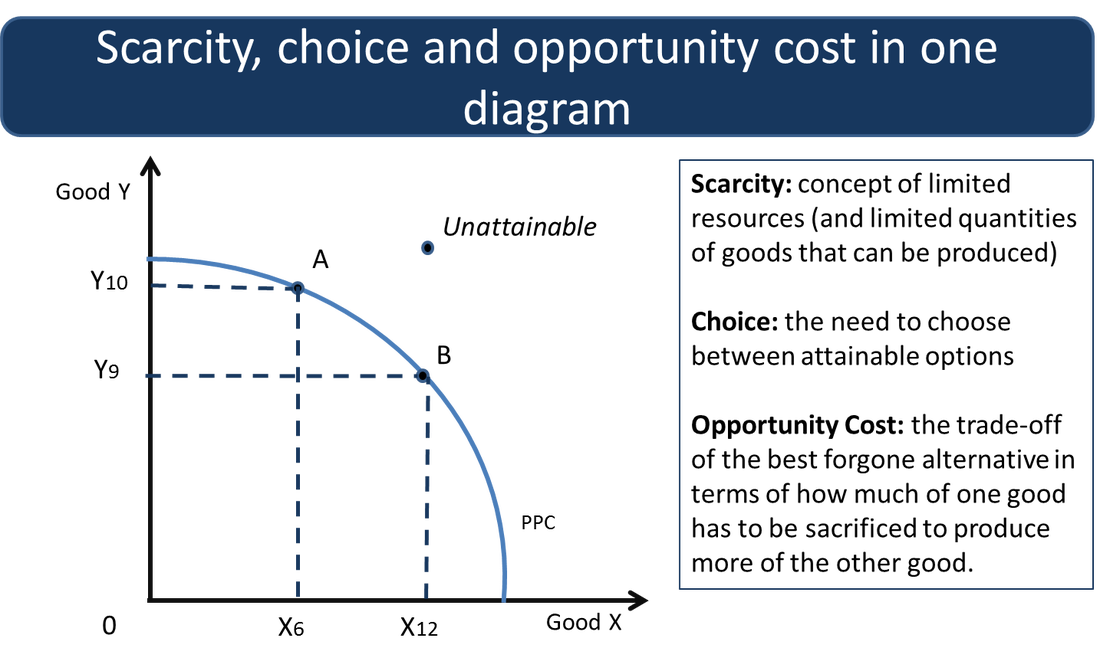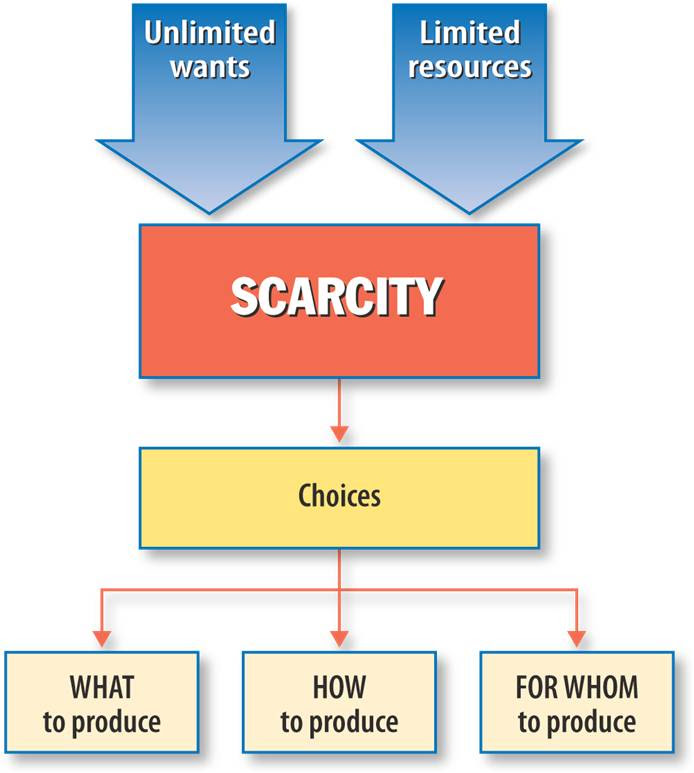AQA Specification focus:
‘The fundamental economic problem is scarcity and that it results from limited resources and unlimited wants; scarcity means that choices have to be made about how scarce resources are allocated between different uses; choices have an opportunity cost.’
The concept of scarcity lies at the heart of economics, shaping the need for choice and introducing the concept of opportunity cost in every economic decision.
Understanding Scarcity
Scarcity arises because resources — such as land, labour, capital, and enterprise — are finite, while human wants are unlimited. Even with technological advances, the total availability of resources is limited, meaning not all wants can be satisfied. Scarcity is not the same as shortage; it is a universal and ongoing condition.
Scarcity: The basic economic problem where finite resources are insufficient to meet all human wants.
Scarcity forces individuals, firms, and governments to make decisions on how best to allocate available resources to competing uses.

The Production Possibility Frontier (PPF) diagram demonstrates the maximum combinations of two goods that can be produced with a fixed set of resources. Points on the curve represent efficient production levels, while points inside indicate underutilisation of resources. The slope of the curve illustrates the opportunity cost of shifting resources between goods. Source
The Role of Choice
Because resources are scarce, economic agents must make choices about:
What to produce — deciding which goods and services should be created.
How to produce — determining the methods and resources to be used in production.
For whom to produce — deciding how goods and services are distributed among people.
These three fundamental questions arise in every economy, whether it is market-based, planned, or mixed. The selection of one option over another inevitably leads to trade-offs.
Trade-off: A situation in which choosing more of one thing results in having less of another.
Trade-offs occur because resources devoted to one area cannot simultaneously be used elsewhere.
Opportunity Cost
Every choice involves a cost in terms of the next best alternative forgone. This is known as opportunity cost, a key analytical tool in economics.
Opportunity Cost: The value of the next best alternative that is given up when a choice is made.
For example, if a government spends more on healthcare, the opportunity cost might be fewer resources available for education or infrastructure.
Scarcity in Different Economic Agents’ Decisions
Scarcity impacts all levels of decision-making:
Individuals
Decide how to spend income and time.
Choosing leisure over work has the opportunity cost of lost earnings.
Firms
Allocate resources between different products or markets.
Choosing to invest in new machinery may mean fewer funds for marketing or research.
Governments
Distribute budgets between departments and projects.
Funding defence projects may limit spending on welfare programmes.
In each case, scarcity means that allocating resources to one priority limits their availability elsewhere.

This flowchart illustrates the economic problem: unlimited wants versus limited resources. It shows how scarcity leads to choices about what to produce, how to produce, and for whom to produce, each involving opportunity costs. Source
The Link Between Scarcity, Choice, and Opportunity Cost
These three concepts are interlinked:
Scarcity creates the need for choice.
Choice inevitably leads to an opportunity cost.
Without scarcity, there would be no need for choice, and thus no opportunity cost.
Key Relationships:
More of one good means less of another.
Choosing one policy direction means sacrificing alternatives.
Efficient allocation seeks to minimise opportunity cost and maximise benefit.
Scarcity in Resource Allocation
In any economy, scarce resources must be allocated between competing uses:
Market allocation: Prices act as signals to direct resources to where they are most valued.
Government allocation: Decisions made through political processes may prioritise equity, social welfare, or strategic goals.
Factors influencing allocation include:
Resource availability.
Technological capabilities.
Societal values and political priorities.
Opportunity Cost and Efficiency
Understanding opportunity cost helps evaluate the efficiency of resource use:
Productive efficiency: Producing at the lowest possible cost.
Allocative efficiency: Resources allocated to produce the goods and services most desired by society.
A choice may be productively efficient but allocatively inefficient if it fails to reflect society’s preferences.
Illustrating Opportunity Cost
While this subsubtopic does not require diagrams, production possibility frontiers (PPFs) are often used to represent scarcity, trade-offs, and opportunity cost. Points on the PPF show maximum feasible output combinations given current resources and technology, with the slope representing opportunity cost.
Opportunity Cost in Policy Decisions
Policy-makers weigh opportunity costs when deciding between competing projects. For example:
Investing in renewable energy may have the opportunity cost of slower short-term economic growth compared to fossil fuel expansion.
Allocating more resources to social housing may limit investment in transport infrastructure.
These decisions involve both positive analysis (examining factual consequences) and normative judgements (based on values).
Factors Affecting Opportunity Cost
Time frame: In the short term, opportunity costs may be high due to fixed resources; in the long term, adjustments may reduce them.
Resource mobility: If resources can be easily reallocated, opportunity costs are lower.
Information: Better information about alternatives helps in making more efficient choices.
Summary of Key Points for AQA Focus
Scarcity results from limited resources and unlimited wants.
It forces choices to be made about what, how, and for whom to produce.
Every choice has an opportunity cost — the next best alternative forgone.
Understanding these concepts is fundamental to economic analysis and policy-making.
FAQ
In the short term, resources are often fixed, making opportunity costs higher because reallocation is difficult. For example, machinery cannot be quickly repurposed for another product.
In the long term, resources can be adjusted more easily, allowing for investment in new technology or training, which can reduce opportunity costs. Planning horizons influence how flexible choices can be.
Yes, but only in rare cases where the choice of one option does not reduce the availability of another.
This can occur when resources are underutilised — for example, if a factory is producing below capacity, producing more of one good may not require sacrificing another. However, in most real-world scenarios, opportunity cost is present.
Governments can:
Improve efficiency in public spending.
Invest in multi-purpose infrastructure that serves several needs.
Use cost–benefit analysis to identify policies with the greatest net benefits.
Minimising waste, corruption, and duplication in projects also helps ensure resources are used where they yield the highest value.
Better information allows decision-makers to evaluate alternatives more accurately, reducing the risk of allocating resources to less valuable uses.
For example, market research can help firms avoid investing in products with low demand, while governments can use data to target social programmes more effectively.
Opportunity cost applies to time, effort, and other non-monetary resources.
Choosing to spend time studying for an exam may mean sacrificing leisure or part-time work hours. Recognising these trade-offs helps individuals make choices aligned with their priorities.
Practice Questions
Define the term "opportunity cost" and give one example in an economic context. (2 marks)
1 mark for a correct definition: Opportunity cost is the value of the next best alternative that is forgone when a choice is made.
1 mark for a relevant example in an economic context, e.g., "If a government spends more on healthcare, the opportunity cost might be fewer resources for education."
Using a production possibility frontier (PPF) diagram, explain how scarcity leads to choices and the concept of opportunity cost. (6 marks)
1 mark for correctly labelling and drawing a PPF diagram showing two goods.
1 mark for showing and labelling a movement along the curve to illustrate a trade-off.
1 mark for explaining that scarcity exists because resources are limited but wants are unlimited.
1 mark for explaining that scarcity forces choices about resource allocation.
1 mark for defining opportunity cost in context of the diagram.
1 mark for linking the concept of opportunity cost to the movement along the PPF, showing what is forgone in producing more of one good.

